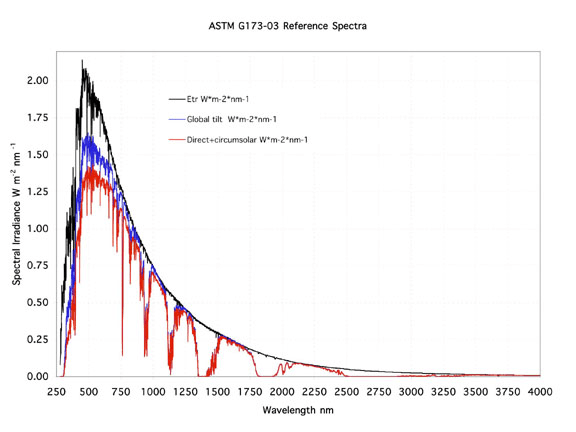Reference Air Mass 1.5 Spectra
The American Society for Testing and Materials (ASTM) G-173 spectra represent terrestrial solar spectral irradiance on a surface of specified orientation under one and only one set of specified atmospheric conditions.
These distributions of power (watts per square meter per nanometer of bandwidth) as a function of wavelength provide a single common reference for evaluating spectrally selective PV materials with respect to performance measured under varying natural and artificial sources of light with various spectral distributions. The conditions selected were a reasonable average for the 48 contiguous U.S. states over a period of one year. The tilt angle selected is approximately the average latitude for the contiguous U.S.A.
The receiving surface is defined in the standards as an inclined plane at 37° tilt toward the equator, facing the sun (i.e., the surface normal points to the sun, at an elevation of 41.81° above the horizon).
The specified atmospheric conditions are:
- The 1976 U.S. Standard Atmosphereb with temperature, pressure, aerosol density (rural aerosol loading), air density, molecular species density specified in 33 layers
- An absolute air mass of 1.5 (solar zenith angle 48.19°s)
- Angstrom turbidity (base e) at 500 nm of 0.084c
- Total column water vapor equivalent of 1.42 cm
- Total column ozone equivalent of 0.34 cm
- Surface spectral albedo (reflectivity) of light soil as documented in the Jet Propulsion Laboratory ASTER Spectral Reflectance Database.
See the description of U.S. standard atmosphere.
The spectra are modelled using the SMARTS2 (version 2.9.2) Simple Model for Atmospheric Radiative Transmission of Sunshine of Gueymard. (See Gueymard 2001 and Gueymard 2003).
The air mass zero (AM0), or extraterrestrial spectrum used to generate the terrestrial reference spectra was developed by Gueymard and is a synthesis of several air mass zero data sets. (See Gueymard 2004 for an historical perspective.) Note the spectrum used in conjunction with SMARTS to produce the reference spectra is not the air mass zero spectrum in ASTM E-490-99, as there are slight differences in bandpass and spectral resolution for the two spectra.
The fields in the table Direct and Global 37 Deg Tilt: ASTM G-173 are wavelength in nanometers (nm), the (Gueymard 2002) extraterrestrial spectral irradiance, direct normal spectral Irradiance (W/sm/nm), and the global total spectral irradiance (W/sm/nm) on the 37° sun-facing tilted surface for the atmospheric conditions specified above.
To convert nanometers to μm, divide by 1000. To convert W/sm/nm to W/sm/μm, multiply by 1000.
A plot of the two distributions is shown here.

The reference spectra were first generated as separate standards, designated as E-891-82 and E-892-82 (for direct normal and global tilt, respectively). As of June 1999, ASTM Subcommittee G3.09 combined the two documents into the single standard "Standard Tables for Reference Solar Spectral Irradiance at Air Mass 1.5: Direct Normal and Hemispherical for a 37 Degree Tilted Surface" The relevant international standard is ISO 9845-1, 1992, based solely upon both E891 and E892. In January 2003, the G-159 standard was revised extensively, and replaced with G-173-03. The older standards E-891, E-892, and G-159 are withdrawn and no longer available except as historical standards. Downloads are provided here for reference and comparison with the G-173 spectra.
Data Files
Access the ASTM G-173-03 tables as a spreadsheet or in a compressed format. By accessing these files, you agree to abide by the NLR data disclaimer.
References
Collins, D.G., and W.G. Blattner, M.B. Wells, H.G. Horak "Backward Monte Carlo Calculations of Polarization Characteristics of the Radiation Emerging from Spherical Shell Atmospheres", Applied Optics, Vol 11, Nov 1972 pp. 2684–2696]
Gueymard, C. "Parameterized Transmittance Model for Direct Beam and Circumsolar Spectral Irradiance," Solar Energy, Vol 71, Issue 5, November 2001, pp. 325–346.
Gueymard,C.; Myers, D.; Emery, K. "Proposed Reference Irradiance Spectra for Solar Energy Systems Testing," Solar Energy, Vol 73, Issue 6, December 2002, pp. 443–467.
Gueymard, C. "The Sun's Total and Spectral Irradiance for Solar Energy Applications and Solar Radiation Models," Solar Energy, Vol 76, Issue 4, April 2004, pp. 423–453.
Kurtz, S. R.; Myers, D.; Townsend, T.; Whitaker, C.; Maish, A.; Hulstrom, R.; Emery, K. "Outdoor Rating Conditions for Photovoltaic Modules and Systems," Solar Energy Materials, 2000, Vol 62 #4. pp. 379–391. See also NREL Report No. JA-520-27160.
Myers, D. R.; Kurtz, S. R.; Whitaker, C.; Townsend, T. Preliminary Investigations of Outdoor Meteorological Broadband and Spectral Conditions for Evaluating Photovoltaic Modules and Systems. Program and Proceedings: NCPV Program Review Meeting 2000, 16-19 April 2000, Denver, Colorado. BK-520-28064. Golden, CO: National Renewable Energy Laboratory; pp. 69–70; NREL Report No. CP-560-28187.
Myers, D. R.; Kurtz, S. R.; Emery, K.; Whitaker, C.; Townsend, T. Outdoor Meteorological Broadband and Spectral Conditions for Evaluating Photovoltaic Modules. Conference Record of the Twenty-Eighth IEEE Photovoltaic Specialists Conference--2000, 15–22 September 2000, Anchorage, Alaska. Piscataway, NJ: Institute of Electrical and Electronics Engineers, Inc.; pp. 1202–1205; NREL Report No. CP-520-28860.
United States Committee on Extension to the Standard Atmosphere, "U.S. Standard Atmosphere, 1962: ICAO Extension to 32 Kilometers. Committee on Extension to the Standard Atmosphere." U.S. Government Printing Office, Washington, D.C., 1962
Share
Last Updated Dec. 6, 2025
